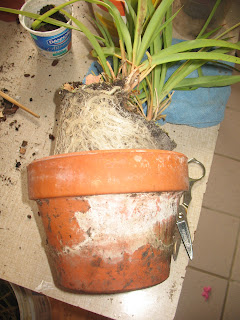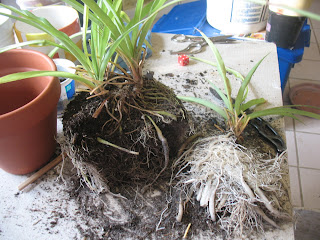From what I understand, the most prolific pests on houseplants are mites and aphids. The first thing to do in looking for any pests is to visually inspect plants. In our area of southeast Minnesota, we had an early-season problem with earwigs - and they were everywhere! I was barely aware of this insect until this season. Fortunately, as the summer progressed, I noticed fewer of them around. And as I now inspect my potted plants, I have yet to see even one. In looking at my plants, I see some damage that was caused when I allowed some of my plants to dry out too much. Most plants look okay, except for my Christmas cactus. These plants have obvious signs of having been on the dinner buffet of some insect. I hope they left a good tip! Other than outright damage, some pests leave clues to their presence. The clues can include small spider-like webs, honey dew (sticky drops on plant surfaces), and blemishes to the plant foliage. And the scariest (to me) sign I found was when I was putting a hosta in the ground in September and found a webby mass in the bottom of the pot. Assuming these were spider eggs, I was happy to leave them outside.
Whatever the pest, I want to be sure to not host them in the house this winter. Also, I want to try to care for my houseplants better than I have done in the past. So, I first inspected the plants for signs that any pest was still in the plants that I brought in. I did see some mealybugs, as well as a few stray webs on another plant. But most looked pretty good. And these pests and signs can be easily removed by running water over the foliage or wiping with a cloth or sponge.
As I brought the plants indoors, I also realized that there were some that needed to be repotted. And this would help me to be sure there were no more of those hidden treasures, in the form of spider eggs, in the bottom of the pots! I also had a few geraniums that were still resting comfortably in the small plastic pots in which I had purchased them. So, there was work to do.
In repotting, it is important to understand when to do it. My theory is to not waste the resources, if it's not necessary. Here's a picture of a spider plant (Chlorophytum comosum) that had a few issues.
The pot was dirty and had a lot of salt deposits on it. So, I thought it best to clean it up. Then, when I took it out of the pot, here is what I found:
I had no idea the plant was so root bound. I knew there were at least three plants in the pot, but assumed they were doing okay. With that, I knew I had to split at least the two main clumps apart. The first step was to make sure I had pots to put them into. My original thought was to simply clean the pot and put it back in the same one. I could still do this, but now had to have a second pot. I used a 1:9 ratio of bleach to water and cleaned the original. I scrubbed it with a wire brush and a toothbrush (retired from teeth work, of course!). After rinsing, the pot looked pretty good.
With that done and the second pot ready, I now had to split the plants.
Although I really don't like cutting roots, it is one way to stimulate new growth and had to be done to get these plants apart. And this potted group of plants would probably have started to suffer, as a result of being so bound. After splitting, I potted the parts into to pots using fresh potting soil.
I also potted others, but still have some to do. As the winter progresses, I hope to work on my houseplants more and have them a bit happier when spring comes around. Of course, these winters can be rather long with cool temperatures, dry conditions and less-than-idea light, so this will be a major feat to accomplish! I hope this helps and good luck to all you working to achieve the same!




No comments:
Post a Comment